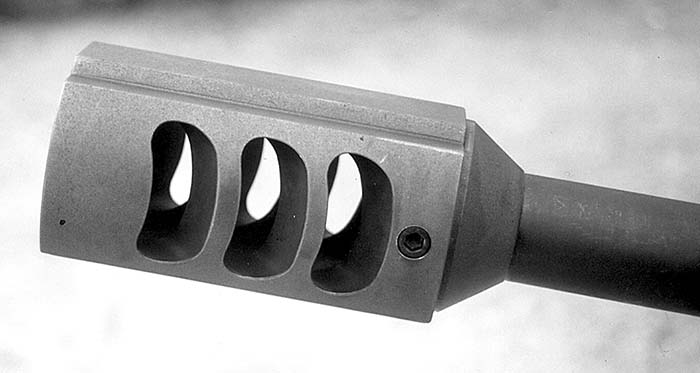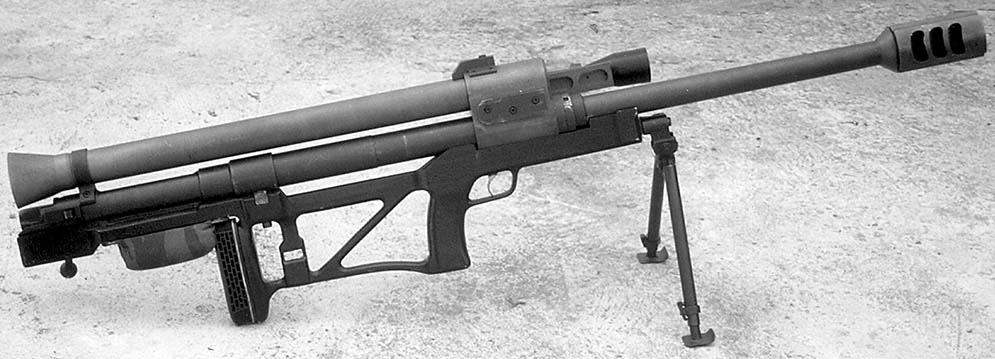RT-20
By Jani Kotnik
In the civil war in former Yugoslavia all parties have extensively used a lot of different sniper rifles. There are at least three known Croatian sniper weapons: a 7.62 mm bolt action (a Steyr SSG type); the 12.7 mm MACS firing a Browning cartridge and the 20 mm RT-20.
The original RT-20 has been successfully used by the Croatian army for three years, on every battlefield in Croatia and in Bosnia and Herzegovina. The RT-20 is a shoulder-fired weapon that falls into the anti-material rifle category. There is a question about how can we classify a 20 mm weapon, which fires shells normally used in AA cannons, as a rifle. The official name for the weapon is RT-20 (Rucni top 20 – Hand Canon 20) and it fires a 20 x 110 Hispano Suiza HS 404 round.
RT-20
The RT-20 is a single shot bolt-action cannon (or a rifle if you wish) with a manually operated bolt handle on the left side of the receiver. The receiver is screwed on the barrel which has eight RH groves. Bullpup layout reduces the length of the weapon, and the bolt is at the extreme rear of the weapon above and to the rear of the butt plate. A standard Pachmayr recoil pad is attached to the butt plate. Bolt weighs around 3 kg and has three sets of locking lugs (modified Weatherby system), opened by raising the bolt handle through 60 deg. The weapon has no safety device, once the bolt is moved forward and locked, it can be fired.
The whole system is based on the modified Parker Hale bipod, with assistance of the small monopod at the back of the stock. Ordinary riflescopes are not suitable for a weapon like RT-20 because of the lack of elevation adjustment for long-range shooting. RT-20 has a modified Austrian riflescope Kahles ZF 84 6 x 42, which has a special reticle to allow trajectory holds instead of clicking in elevation changes. On the right side of the gas block there is a rail for a rack (backpack) to carry the weapon for long distances.
Reducing recoil
The firing of a 20 mm weapon from the shoulder has always posed recoil problems because of the size of the propellant loads, so the manufacturer has made a significant effort to reduce the heavy recoil. He used a semi recoilless system with two gas brakes which reduce forces of recoil on shooter’s shoulder.
About half way down the barrel there is a block with a gas port facing upwards (gas chamber). As the projectile passes this point some of the propellant gases are tapped off and directed along recoil compensator tube to be vented behind and above the bolt area. At the end of the tube there is a cone shaped area (Venturi funnel) with an arc of 60 deg. Because of the back blast this weapon is hazardous when it is fired from a position where the walls are directly behind it. (back blast is 1 meter long).

The rearward escaping gases also means that the shooter cannot assume an orthodox firing position. He must sit or lie at an angle to the left of the receiver, his right shoulder supporting the weapon and assuming some of the recoil forces. Because of the shooter’s position, the bolt handle is on the left side of the receiver.
Recoil forces are further reduced by a very efficient multi-baffle muzzle break. The sophisticated muzzle brakes have an effect of “pulling” the gun forward by directing the muzzle blast sideways and backward. The combination of these two gas brakes makes recoil spread over a long duration, essentially the recoil has two phases, and it makes the recoil more like a “push” instead of ka-slam.
Ammunition
To understand the potential we have, we shall look at the ammunition – a cannon ammunition, M57 20 x 110. This is the Yugoslav version of an Hispano Suiza cartridges 20 x 110 HS 404, which was produced in 1930s and subsequently adopted by Britain and USA during the Second Word War. Several other countries adopted the AA cannons and ammunition of this pattern. This ammunition is still manufactured in Belgium, Italy and Yugoslavia.
Cartridge cases of steel or brass can be found. Ignition is made by conventional percussion cap pressed into the base of the case. Projectiles vary from solid armor-piercing to explosive and incendiary projectile with impact fuses. The Yugoslav version M57 has a self destructing fuze which will time destruct the outgoing shell from 4.5 to 9.5 second intervals, thus the maximum range for HE-I shell is from 1800 meters up. The HE-I shell is yellow colored, the armor-piercing/incendiary AP-I M60 which has a steel core with incendiary filling is colored black with a red stripe. According to the details from FN for 20mm ammunition, the muzzle velocity of the ammunition is 845 m/s. The velocity test of RT-20Mk2 showed a reduced velocity of 750 m/s with a standard deviation of 0.3 m/s. The AP will penetrate a 20 mm steel armor plate at 200 meters. The explosion of the HE-I shell will produce fragments with a 5 m lethal radius. The nature of the ammunition indicates that the RT-20 can be used as an anti-material and also as an anti-personnel weapon.
Use of RT-20
With the weights of 27 and 18 kg (RT20Mk2) the RT-20 are very handy weapons. They can be used in commando styled operations, as a sniper and counter-sniper weapon and especially as an anti- material weapon. It will destruct all soft skinned vehicles and penetrate the side armor of light armored vehicles, helicopters or aircraft on the airfield. A trained shooter can hit a pin point target such as an enemy soldier at a range of 1500 meters and more, only limited by the accuracy and quality of the cartridge. The Croatian forces have used a tactic to insert commando groups with an RT-20 in the rear of enemy positions to attack fire bases, convoys, command posts and all valuable targets in range of 2000 meters.
RT-20 has a significant firing signature, a muzzle blast at night and sound which will identify the firing position to the enemy. So the best tactic would be to shoot and scoot, if we tried to avoid a retaliation from opposition.
Test firing of RT-20 MARK 2
The basic model of the RT-20 has a total weight of some 27 kg, and it is made of steel and aluminum. The author of this text was privileged to test fire the prototype of 20 mm RT-20 Mark 2. The RT-20Mk2 is a light version with a reduced weight of 18.5 kg, and it is made of steel, aluminum and titanium. The receiver, barrel and bipod are made of steel, stock is from aluminum, the muzzle brake, gas chamber and retro active gas tube are from titanium.
Can you imagine an 18 kg weapon firing a huge 20 mm AA cartridge? Calculation with PCB 1.3 software, has shown that the physical recoil is 516.9 J of energy, with recoil velocity of 7.5 m/s. The twin brakes on RT-20 Mk2 must reduce a recoil to manageable level, to be handled by a normal sized man or a woman.
The test was undertaken on the Croatian military range under the supervision of designer.
Before going any further, I must admit that I was also tested at the firing. My first encounter with 20 mm ammunition was during the close firing of a M57 AA cannon. To discuss recoil, one 9.3 x 72R cartridge fired from a double barreled rife left a memorable signature on my nose. Combine the huge back blast of a M57 cannon and the recoil of a “mild” big game rifle, and you will establish respect for this powerful rifle. However, we were there on our own request, and a man’s got to do what man’s got to do.
The designer of RT-20 told me that I had to lean on the cannon and force it forward, in his words: “This is a man`s rifle which has to be treated properly”. The first shot went out to the 200 meter mark because I didn’t aim- I was trying to learn about and get accustomed to the recoil. When the shot rang out, I was pushed by the heavy force, but my shoulder stayed in place and I was in a single piece and OK. Then we started hunting for targets, and the second shot went to the 400 meters mark to cut down a pine tree (2 meters tall). The third shot was placed on a square meter target at 1000 meters, the fourth and the fifth were dead on at targets 1400 meters away. The sixth was a long shot at the 2000 meter mark. All targets were the same, a square meter of white paper. Because we had an ammunition lot with self destructive fuse set at 4.5 s a shell exploded at some 1800 meters, but the path was in line with the target, so we can assume a clear hit if we had different ammunition. Inspections of the targets show that some were totally gone, others were well perforated with shell splinters.
The weapon fired was a fine piece of art, with pint-point accuracy – easy to hit a man size target out to 1500 meters or more. But that is not important, the main reason to have this weapon in your arsenal is based on the destructive potential of 20 mm projectiles, with their ability to carry an explosive payload and penetrate light armor. Cost efficiency of the system is obvious, a single 30 US dollar well placed shell can destroy multi million dollar equipment; vehicles, choppers etc. at 2000 meters or more.
| This article first appeared in Small Arms Review V4N2 (November 2000) |











